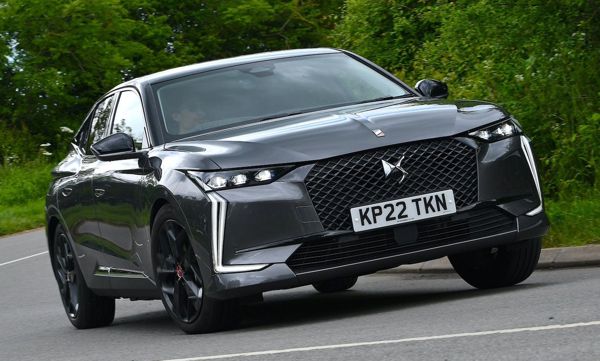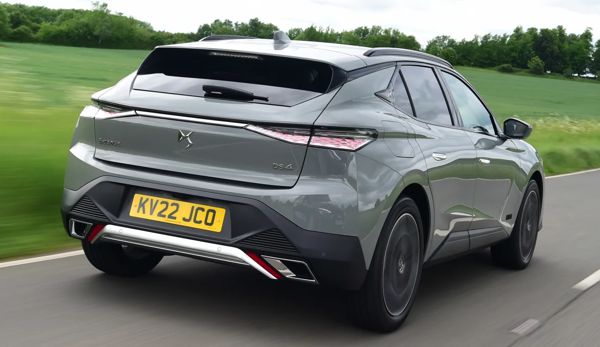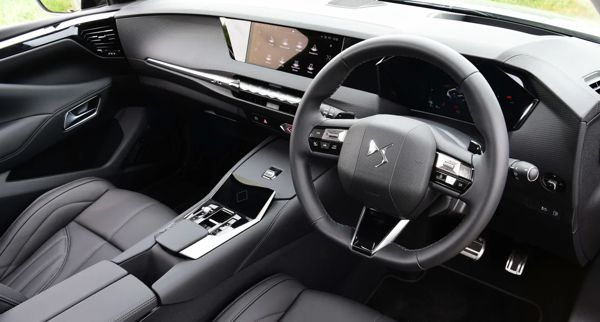Published
on 12
Oct 2022
|
All rights reserved.
|
|
|

|
|
DS
tries to out-luxury German premium cars, and it is partly successful.
|
|
Make no mistake, the DS4
is not an SUV-crossover. Yes, it is deliberately styled to look like
one, but no SUV-crossover could be so low, standing just 1470 mm above
the ground. That’s the same as, say, a Mercedes E-class saloon.
To deliver that SUV-alike looks, the DS4 uses larger wheels, from the
standard 19-inch all the way to the largest 21-inch option. However,
they are only 205mm wide, contributing no more friction and drag.
Moreover, this car is purely front-wheel-drive, and it employs the same
small engines and PHEV powertrain as other conventional hatchbacks
produced by the group, so any talk of SUV is either illusions or
marketing tricks.
Building on the group’s EMP2 platform, the new DS4’s specifications are
totally predictable. It rides on struts suspension up front and a
torsion beam at the rear axle. PHEV model has the latter replaced with
a more sophisticated multi-link setup. All models employ 8-speed
automatic transmission which was licensed by Aisin and produced by
Stellantis itself in France. Manual gearbox is not even an option.
There are only 3 engines on offer: 1.2-liter PureTech 3-cylinder turbo,
1.6-liter PureTech 4-pot turbo and 1.6 HDi turbo diesel. The 3-cylinder
petrol and the diesel produce 130 hp, while the 4-cylinder petrol
either 180 hp or 225 hp. PHEV uses the 180 hp 1.6 to mate with a 109 hp
electric motor and generates 225 hp. Both the 225 hp petrol and PHEV
are
good for 0-60 mph in around 7 and a half seconds, quick enough but no
fireball.

|
|
Chassis
tuned for luxurious ride at the cost of body control.
|
|
Until now, it all sounds predictable, and you can easily come up to a
conclusion that this is just another mediocre PSA product. The reality
is both yes and no. In terms of driving dynamics, yes, it has nothing
to surprise. Tuned in French fashion, the suspension is soft, resulting
in quite a lot of lean in corner and a floaty ride over undulations at
medium speed driving. You may opt for adaptive dampers with road
scanning predictive technology, which uses a camera to detect bumps
ahead and adjust damper stiffness accordingly, to improve things a
little. Switch to sportier modes will calm down the float but also
destroy the sense of magic carpet – it is just not as versatile as
Citroen / DS wants you to believe. The steering is light and slow and
devoid of feedback. The brake pedal feels soft. The narrow tires offer
limited grip. The DS4 is by no means a driver’s car.
However, it does a pretty good job to feel luxury. Low speed ride
comfort is exceptional, especially on poorer roads. Noise insulation
can easily beat German rivals, even at high-speed cruising, giving you
a hushed environment to enjoy the luxurious cabin. The PHEV powertrain
is quite refined, blending the two power sources seamlessly. Just don’t
rev it too hard, as the 1.6 engine could be loud and coarse. The
automatic transmission is also flawed, blame to inconsistent and poorly
timed shift points. The French has never been good at sorting out
gearboxes. The DS4 feels most refined under relaxed driving.

|
|
Interior
can easily beat German rivals for quality as well as sound insulation.
|
|
The DS4’s trump card is packaging. The exterior is more head-turning
than any small BMW and Audi. Its diamond-patterned grille, sharp
headlights and signature LED light stripes combined with that high
waistline, low roofline and long bonnet proportion is easily sportier
and more aggressive than its premium rivals. The interior is equally
desirable. Tastefully styled and trimmed with cosy materials,
especially black leather and Alcantara on top trim level. Again it
trumps its German rivals for premium feel. A good example of French
luxury.
On the downside, the rear seat is tight in both head and knee room, a
problem shared with most PSA compact cars. Six-footers will find there
intolerable for anything other than a short trip. Ergonomics is also
a bit flawed. Some switches are placed at illogical positions, while
the
user interface of infotainment system is not as easy to use as its more
established rivals. You may also dislike the lack of airiness of the
cabin, blame to the low roof, shallow windows and all-round dark trims.
All in all, this is typical French car, being great at style and
comfort but flawed in some dynamics and practicality aspects. It has a
strong character, but not for every one's taste.
|
Verdict:    |
|
|
|
|
|
|
|
|
|
|
DS4
Puretech 130
|
2022
|
| Front-engined,
FWD |
| Steel monocoque |
Mainly steel
|
| 4400 / 1830 / 1470 mm |
| 2675 mm |
Inline-3
|
| 1199 cc |
DOHC 12 valves, DVVT
|
Turbo
|
| DI |
130 hp
|
170 lbft
|
8-speed automatic
|
F: strut; R: torsoin-beam
|
-
|
| 205/55VR19 |
1352 kg
|
130 mph (c)
|
9.4 (est)
|
-
|
|
DS4
Puretech 225
|
2022
|
| Front-engined,
FWD |
| Steel monocoque |
Mainly steel
|
| 4400 / 1830 / 1470 mm |
| 2675 mm |
Inline-4
|
| 1598 cc |
DOHC 16 valves, DVVT, VVL
|
Turbo
|
| DI |
225 hp
|
221 lbft
|
8-speed automatic
|
F: strut; R: torsoin-beam
|
-
|
| 205/55VR19 |
1419 kg
|
146 mph (c)
|
7.5 (c)
|
-
|
|
DS4
E-tense 225
|
2022
|
| Front-engined,
FWD |
| Steel monocoque |
Mainly steel
|
| 4400 / 1830 / 1470 mm |
| 2675 mm |
Inline-4 + electric motor
|
1598 cc, battery 12.4kWh
|
DOHC 16 valves, DVVT, VVL
|
Turbo
|
| DI |
180 + 109 = 225 hp
|
221 + 236 = 265 lbft
|
8-speed automatic
|
F: strut; R: multi-link
|
Adaptive damping
|
| 205/55VR19 |
1653 kg
|
145 mph (c)
|
7.3 (c) / 7.4*
|
16.6*
|
|
|
|
|
|
Performance
tested by: *Autocar
|
|
|
|
|
|
|